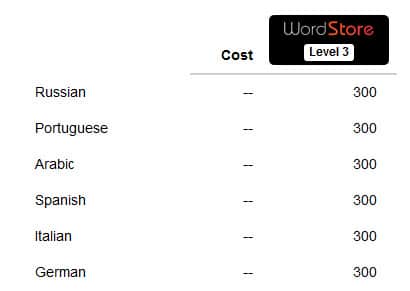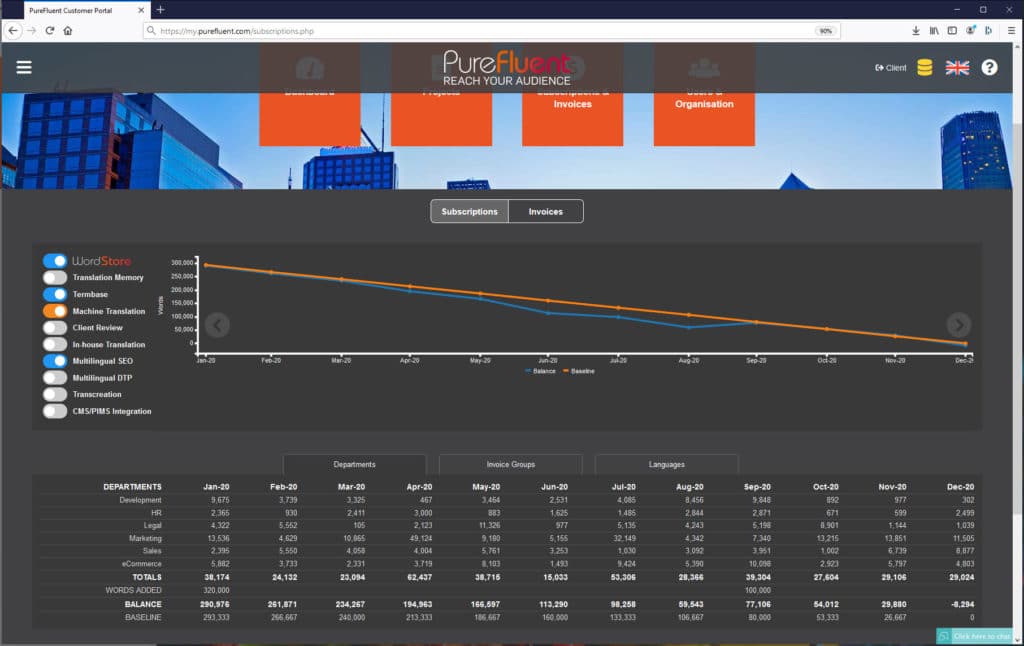Ian and Tim are speaking today about the launch of PureFluent’s translation subscription service, the first of its kind in the industry.
Ian:Tell us all about this new subscription service that PureFluent is launching.
Tim:We’re very excited about the launch of a range of translation subscription services for our customers. These include a subscription called WordStore, which for a fixed monthly fee allows our customers to get access to all the translation services they need. This is something we’ve been working on pretty much flat out for six months, and we think it’s a real game changer in the translation industry.
The subscriptions available not only cover your translation requirements, but also some of the associated services including multi-lingual SEO, multi-lingual DTP, Transcreation and some of the more technical aspects of translation such as integrating with content management systems. All of this is geared towards the goal of allowing a customer access to all the translation services required with a single, flat monthly fee.
Ian:Why are you launching subscription-based translation services?
Tim:It’s a response to some of the underlying failings of the translation industry. There’s too much complexity associated with running translations for most customers, so one of our goals for a long period of time has been to simplify and bring transparency to the process. This has involved looking at all of the processes around ordering and paying for translations, boiling them down to something that is much simpler and much more predictable.
If you think about the way that someone might order a translation at the moment, it probably involves raising a purchase order, getting that purchase order approved, receiving multiple invoices in the course of a typical month and getting those invoices paid, and keeping track of what your outstanding balance is with your translation services provider. The customer then needs to come up with a clear understanding over a period of time of what he’s used, which areas he’s used it in, and which projects it’s been used for, and to then forecast what is going to be used during the next budget cycle.
What we’re aiming to do is make this entire process simple and transparent for our customers.
Ian:How will customers be able to track what they’ve used and their remaining balance?
Tim:Let’s use the example of the WordStore subscription specifically. You might be translating into a number of different languages, and if you are translating into say French, German and Spanish, most agencies will charge a slightly different rate for each, but if you also translate into Japanese and Norwegian everyone charges a lot more for those two.
The first concept of the translation subscription service is that we have a single “blended rate” for translation – so a word is a word is a word. You opt in for the languages that you need and order translations as required; you no longer have to think about such things as Norwegian costing more than French because it’s all part of your subscription.
A second aspect of this service is that you pick a subscription level. We offer levels from 1 to 15, which provides access to a block of words; a level 1 subscription gives access to 80,000 translated words per year, and level 15 gives access to 1,200,000 words a year. We can help customers determine which level is most appropriate for their needs, and once this is decided the process is done for a year – set and forget. For example you may choose a level 3 subscription, which provides 240,000 translated words a year, and you then make a monthly payment and order your translations without having to think about the process again, drawing from your block of words as needed.
It’s typical for customers to have a high level of fluctuation in their translation needs, with perhaps a varying level of run rate or a substantial requirement around a website launch. The subscription’s flat rate per month helps to smooth out these fluctuations.
A really important point is that once you’ve picked your WordStore subscription level you can add words or move up a level if you need to, and in subsequent periods you can move up or down a level as required. If you have unused words at the end of a year you can carry them over into the next subscription period.
Ian:If you carry over say 16,000 words from your Level 3 subscription to the next period, assuming you remain at level 3 you’ll then have 256,000 words to use the following year, correct? 240,000 plus 16,000 right?
Tim:Exactly, or you might find if you’ve gone over your limit on level 3 and choose to move up to level 4. Or vice versa, if you’re at too high a level for your future needs, you can carry over unused words from the previous period and move down a level. Again, the goal is simplicity and transparency, avoiding financial surprises of any sort and monitoring precisely what your overall translation use has been month by month.
The monitoring of the customer’s words used happens in real time. Every time an order is placed the number is registered against your subscription, and the Balance Chart provides shows exactly what you’ve used, and what you still have “in the bank”.
This is really easy to follow and when the boss asks you “What are we doing in regards to translation costs?” it allows you to quickly show exactly what you’ve used and what you’re expecting to use.
Ian:How does the subscription model differ then from the traditional client and translation agency relationship?
Tim:Pretty much all translation agencies work on a per project basis broken down into per word pricing from language to language. The translation subscription service allows the customer to pay that single monthly fee which is set for 12 months – no muss, no fuss! This provides a huge advantage in terms of simplicity because the commitment is made at the start of the subscription period and sign off on each project isn’t required. Transparency and simplicity have been watchwords through all our developments of the past few years, not just for the commercial processes but for each project that we run.
Ian:And as far as you’re aware no other translation services agencies are offering this?
Tim:We don’t think so. There are thousands of translation companies so we may have missed some, but we’ve talked to many of the leading authorities in the industry and we think we’re the only company offering a translation services subscription right now.
Ian:Why has taken someone so long to come up with this idea?
Tim:The key question is whether it’s down to resistance from customers or resistance from translation suppliers. I think the answer is that it’s been resistance from suppliers. Without exception all the customers that we’ve spoken to grasp the idea immediately; that doesn’t mean that every customer we have is going to sign up for a subscription, but everyone gets it and likes the simplicity and the transparency. There are however some mental blocks from suppliers that they have to get over. Different languages cost translation services providers different amounts as we’ve discussed, so saying that a customer can order a thousand words of Norwegian for the same cost as a thousand words of Spanish goes against the grain for most agencies.
The translation subscription service allows the customer to pay that single monthly fee which is set for 12 months. This provides a huge advantage in terms of simplicity because the commitment is made at the start of the subscription period and sign off on each project isn’t required.
It doesn’t actually take a great deal of imagination to work out how to accommodate that, but you do have to have a mind-set that you’re prepared to accept some projects will be unprofitable and other projects will be more profitable. But overall we are making a sensible level of margin and in return the customer gets that simplicity – that’s the big win for the customer and for us.
A lot of agencies are also are a bit old fashioned and not very tech savvy, but we have a talented and growing software development team and we have the necessary vision about what we want to achieve. We need those technical skills within the business in order to deliver something with this kind of online functionality.
Ian:What sort of customers will benefit from the subscription?
Tim:Customers that are going to get the most benefit are obviously those that are ordering translations on a regular basis. If you have a one-off translation project such as a website translation you don’t have the same level of need or challenge, but that said website translation projects rarely happen in isolation because there’s almost always some sort of ongoing requirement for translation. Many people also undertake regular marketing campaigns – email or social media marketing for instance – and require ongoing blog content and press releases, or content that services product launches.
Once most customers have started translating they will have ongoing translation requirements, so many customers would in fact benefit from the translation subscription service in some way, shape or form.







